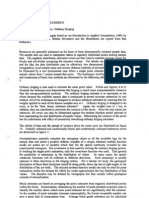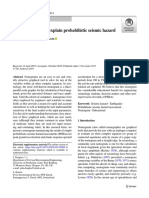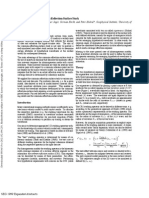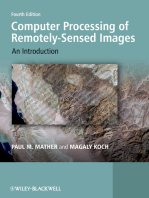Arango (1996) Scaling Factors: Table 3
Arango (1996) Scaling Factors: Table 3
Uploaded by
RaghavCopyright:
Available Formats
Arango (1996) Scaling Factors: Table 3
Arango (1996) Scaling Factors: Table 3
Uploaded by
RaghavOriginal Description:
Original Title
Copyright
Available Formats
Share this document
Did you find this document useful?
Is this content inappropriate?
Copyright:
Available Formats
Arango (1996) Scaling Factors: Table 3
Arango (1996) Scaling Factors: Table 3
Uploaded by
RaghavCopyright:
Available Formats
TABLE 3.
Seed and
Idriss
(1982)
5.5
6.0
6.5
7.0
7.5
8.0
8.5
1.43
1.32
1.19
1.08
1.00
0.94
0.89
Magnitude,
Magnitude Scaling Factor Values Defined by Various Investigators (Youd and Noble 1997a)
Arango (1996)
Youd and Noble (1997b)
Idrissa
Ambraseys
(1988)
Distance
based
Energy
based
Andrus and
Stokoe
(1997)
PL < 20%
PL < 32%
PL < 50%
2.20
1.76
1.44
1.19
1.00
0.84
0.72
2.86
2.20
1.69
1.30
1.00
0.67
0.44
3.00
2.00
1.60
1.25
1.00
0.75
2.20
1.65
1.40
1.10
1.00
0.85
2.8
2.1
1.6
1.25
1.00
0.8?
0.65?
2.86
1.93
1.34
1.00
3.42
2.35
1.66
1.20
4.44
2.92
1.99
1.39
1.00
0.73?
0.56?
Note: ? = Very uncertain values.
a
1995 Seed Memorial Lecture, University of California at Berkeley (I. M. Idriss, personal communication to T. L. Youd, 1997).
For magnitudes >7.5, Ambraseys factors are significantly
lower and much more conservative than the original (Seed and
Idriss 1982) and Idrisss revised scaling factors. Because there
are few data to constrain Ambraseys scaling factors for magnitudes >7.5, they are not recommended for hazard evaluation
for large earthquakes.
Arango (1996) Scaling Factors
FIG. 12. Magnitude Scaling Factors Derived by Various Investigators
(Reproduced from Youd and Noble 1997a)
in Fig. 12. The revised MSFs are defined by the following
equation:
MSF = 102.24/M w2.56
Arango (1996) developed two sets of magnitude scaling factors. The first set (column 5, Table 3) is based on furthest
observed liquefaction effects from the seismic energy source,
the estimated average peak accelerations at those distant sites,
and the seismic energy required to cause liquefaction. The second set (column 6, Table 3) was developed from energy concepts and the relationship derived by Seed and Idriss (1982)
between numbers of significant stress cycles and earthquake
magnitude. The MSFs listed in column 5 are similar in value
(within about 10%) to the MSFs of Ambraseys (column 4),
and the MSFs listed in column 6 are similar in value (within
about 10%) to the revised MSFs proposed by Idriss (column
3).
(24)
The workshop participants recommend these revised scaling
factors as a lower bound for MSF values.
The revised scaling factors are significantly higher than the
original scaling factors for magnitudes <7.5 and somewhat
lower than the original factors for magnitudes >7.5. Relative
to the original scaling factors, the revised factors lead to a
reduced calculated liquefaction hazard for magnitudes <7.5,
but increase calculated hazard for magnitudes >7.5.
Ambraseys (1988) Scaling Factors
Field performance data collected since the 1970s for magnitudes <7.5 indicate that the original Seed and Idriss (1982)
scaling factors are overly conservative. For example, Ambraseys (1988) analyzed liquefaction data compiled through the
mid-1980s and plotted calculated cyclic stress ratios for sites
that did or did not liquefy versus (N1)60. From these plots,
Ambraseys developed empirical exponential equations that define CRR as a function of (N1)60 and moment magnitude Mw.
By holding the value of (N1)60 constant in the equations and
taking the ratio of CRR determined for various magnitudes of
earthquakes to the CRR for magnitude 7.5 earthquakes, Ambraseys derived the magnitude scaling factors listed in column
4 of Table 3 and plotted in Fig. 12. For magnitudes <7.5, the
MSFs suggested by Ambraseys are significantly larger than
both the original factors developed by Seed and Idriss (column
2, Table 3) and the revised factors suggested by Idriss (column
3). Because they are based on observational data, these factors
have validity for estimating liquefaction hazard; however, they
have not been widely used in engineering practice.
Andrus and Stokoe (1997) Scaling Factors
From their studies of liquefaction resistance as a function
of shear wave velocity Vs Andrus and Stokoe (1997) drew
bounding curves and developed (22) for calculating CRR from
Vs for magnitude 7.5 earthquakes. These investigators drew
similar bounding curves for sites where surface effects of liquefaction were or were not observed for earthquakes with
magnitudes of 6, 6.5, and 7. The positions of the CRR curves
were visually adjusted on each graph until a best-fit bound
was obtained. Magnitude scaling factors were then estimated
by taking the ratio of CRR for a given magnitude to the CRR
for magnitude 7.5 earthquakes. These MSFs are quantified by
the following equation:
MSF = (Mw /7.5)22.56
(25)
MSFs for magnitudes <6 and >7.5 were extrapolated from this
equation. The derived MSFs are listed in column 7 of Table
3, and plotted in Fig. 12. For magnitudes <7.5, the MSFs proposed by Andrus and Stokoe are rather close in value (within
about 5%) to the MSFs proposed by Ambraseys. For magnitudes >7.5, the Andrus and Stokoe MSFs are slightly smaller
than the revised MSFs proposed by Idriss.
Youd and Noble (1997a) Scaling Factors
Youd and Noble (1997a) used a probabilistic or logistic
analysis to analyze case history data from sites where effects
of liquefaction were or were not reported following past earthquakes. This analysis yielded the following equation, which
JOURNAL OF GEOTECHNICAL AND GEOENVIRONMENTAL ENGINEERING / OCTOBER 2001 / 827
You might also like
- Math 9 Summative Test Direct VariationDocument1 pageMath 9 Summative Test Direct VariationMaricris Dizon-Miguel100% (3)
- Rainfall Statistics of India - 2016Document107 pagesRainfall Statistics of India - 2016RaghavNo ratings yet
- Orn 31 PDFDocument82 pagesOrn 31 PDFRaghavNo ratings yet
- Answer Problem Transformer Rev1Document10 pagesAnswer Problem Transformer Rev1Rodrigo BabijisNo ratings yet
- Estimation of Bridge Pier Scour For Clear Water & Live Bed Scour ConditionDocument6 pagesEstimation of Bridge Pier Scour For Clear Water & Live Bed Scour ConditionIAEME PublicationNo ratings yet
- T5 Y1 WK 5 Math DisDocument5 pagesT5 Y1 WK 5 Math Diskwameworae87No ratings yet
- Soil Liquefaction: 70 Standard Penetration TestDocument6 pagesSoil Liquefaction: 70 Standard Penetration TestMario Alexander Castañeda LópezNo ratings yet
- Selecting and Scaling AccelerometersDocument8 pagesSelecting and Scaling AccelerometerscadelNo ratings yet
- Arm Hovsepyan G Abs2 He12 PosterDocument4 pagesArm Hovsepyan G Abs2 He12 PostergorditoNo ratings yet
- SkillDocument6 pagesSkillVenkat Chandrakanth ANo ratings yet
- Devi Sageep16 Rev1Document7 pagesDevi Sageep16 Rev1Roland Rawlins IgaborNo ratings yet
- Lagrange HidrociclonesDocument7 pagesLagrange HidrociclonesRorroskyNo ratings yet
- A Compendium of Soil Liquefaction Potential Assessment MethodsDocument11 pagesA Compendium of Soil Liquefaction Potential Assessment MethodsBolarinwa AdemolaNo ratings yet
- Seismic Analysis of PilesDocument5 pagesSeismic Analysis of PilesmardiradNo ratings yet
- ISC2020-533 Liquefactin Potential Evaluation SPT BasedDocument6 pagesISC2020-533 Liquefactin Potential Evaluation SPT BasedAGUS KUSWANTONo ratings yet
- MairahDocument3 pagesMairahmairakhokhar45No ratings yet
- Global Attitude/position Regulation For Underwater Vehicles: D M. B M KDocument8 pagesGlobal Attitude/position Regulation For Underwater Vehicles: D M. B M KЋирка ФејзбуџаркаNo ratings yet
- Fault Relay ZoneDocument33 pagesFault Relay Zonefrancarlos de la cruz chuquimangoNo ratings yet
- Topic 1 Attenuation RelationshipDocument7 pagesTopic 1 Attenuation RelationshipGleanna NiedoNo ratings yet
- Steven Miller Et Al - Infrared Emissions of H3 + in The Atmosphere of Jupiter in The 2.1 and 4.0 Micron RegionDocument20 pagesSteven Miller Et Al - Infrared Emissions of H3 + in The Atmosphere of Jupiter in The 2.1 and 4.0 Micron RegionPassammNo ratings yet
- Lequifaction AnalysisDocument7 pagesLequifaction AnalysisrqmuradNo ratings yet
- Not All Dems Are Equal: An Evaluation of Six Globally Available 30 M Resolution Dems With Geodetic Benchmarks and Lidar in MexicoDocument52 pagesNot All Dems Are Equal: An Evaluation of Six Globally Available 30 M Resolution Dems With Geodetic Benchmarks and Lidar in MexicoCarlos GamiñoNo ratings yet
- Ambraseys - Simpson - Prediction of Vertical Response Spectra in Europe PDFDocument12 pagesAmbraseys - Simpson - Prediction of Vertical Response Spectra in Europe PDFMartin Dario Mazo QuingrejoNo ratings yet
- Square Cylinder (Corner Shapes) - 1998tamura PaperDocument12 pagesSquare Cylinder (Corner Shapes) - 1998tamura PaperAjith KumarNo ratings yet
- 3D Slope Stability AnalysisDocument6 pages3D Slope Stability Analysisicabullanguero0% (1)
- AnsaryDocument40 pagesAnsarydhamodharan24No ratings yet
- Settle3D Liquefaction Theory ManualDocument47 pagesSettle3D Liquefaction Theory ManuallingamkumarNo ratings yet
- 3 Story Seismic AnalysisDocument15 pages3 Story Seismic AnalysisKavita Kaur KamthekarNo ratings yet
- UNSW Mining EngineeringDocument16 pagesUNSW Mining EngineeringAgus WinarnoNo ratings yet
- Douglas-Danciu2020 Article NomogramToHelpExplainProbabiliDocument8 pagesDouglas-Danciu2020 Article NomogramToHelpExplainProbabiliVictor Manuel UribeNo ratings yet
- Incidence Angle NormalizationDocument3 pagesIncidence Angle NormalizationNguyen Ba DuyNo ratings yet
- 1999 - Finite Element Modelling of Fatigue Crack Growth of SurfaceDocument16 pages1999 - Finite Element Modelling of Fatigue Crack Growth of SurfaceArun KumarNo ratings yet
- Utilization of Equivalent Spheres of Equal Volume and Surface Area For Estimation of The Asymmetry Parameter From Microphysical Observations JP2.13Document5 pagesUtilization of Equivalent Spheres of Equal Volume and Surface Area For Estimation of The Asymmetry Parameter From Microphysical Observations JP2.13kishorkumarn8212No ratings yet
- Chapter 6Document36 pagesChapter 6harpreetsingh171190No ratings yet
- Three-Dimensional Analysis For The Effect of Piles Geometry and Arrangement On The Dynamic Response of Piled Raft FoundationDocument15 pagesThree-Dimensional Analysis For The Effect of Piles Geometry and Arrangement On The Dynamic Response of Piled Raft FoundationCuongvm92 VuNo ratings yet
- Recoverable Resources Estimation: Indicator Kriging or Uniform Conditioning?Document4 pagesRecoverable Resources Estimation: Indicator Kriging or Uniform Conditioning?Elgi Zacky ZachryNo ratings yet
- The Influence of Grain Size Distribution and Grain Shape On The Small Strain Shear Modulus of North Sea SandDocument10 pagesThe Influence of Grain Size Distribution and Grain Shape On The Small Strain Shear Modulus of North Sea SandHưng Huỳnh TấnNo ratings yet
- Neuber Method For FatigueDocument12 pagesNeuber Method For FatigueKuan Tek SeangNo ratings yet
- Uniform Asymptotic Formulae For The Spheroidal Radial FunctionDocument9 pagesUniform Asymptotic Formulae For The Spheroidal Radial FunctionLuLa_IFNo ratings yet
- IJRR v5n4p169 enDocument6 pagesIJRR v5n4p169 enJaime ACNo ratings yet
- Problemas Bono para Tercer Examen de Estadística - Verano 2012Document8 pagesProblemas Bono para Tercer Examen de Estadística - Verano 2012David Meza CarbajalNo ratings yet
- An Average Flow Model For Determining Effects of Three-Dimensional Roughness On Partial Hydrodynamic LubricationDocument6 pagesAn Average Flow Model For Determining Effects of Three-Dimensional Roughness On Partial Hydrodynamic LubricationKartik DuttNo ratings yet
- Cai and Kaiser 2006 Visualization of The Rock Mass Classification SystemsDocument14 pagesCai and Kaiser 2006 Visualization of The Rock Mass Classification SystemsReza OsgouiNo ratings yet
- Fractured Reservoir Characterization From Seismic Azimuthal Anisotropy and Well Log AnalysisDocument4 pagesFractured Reservoir Characterization From Seismic Azimuthal Anisotropy and Well Log AnalysisSatriaNo ratings yet
- Chapter 10. Simple Regression and CorrelationDocument34 pagesChapter 10. Simple Regression and CorrelationchingyhoNo ratings yet
- P. Rakwatin, W. Takeuchi, and Y. Yasuoka, "Stripe Noise Reduction inDocument13 pagesP. Rakwatin, W. Takeuchi, and Y. Yasuoka, "Stripe Noise Reduction inSachin VaradhanNo ratings yet
- Simplified R-Factor Relationships For Strong Ground Motions: Isabel Cuesta,, Mark A. Aschheim,, and Peter FajfarDocument21 pagesSimplified R-Factor Relationships For Strong Ground Motions: Isabel Cuesta,, Mark A. Aschheim,, and Peter Fajfarsalta2013No ratings yet
- Applications of The Common Reflection Surface StackDocument4 pagesApplications of The Common Reflection Surface StackYudhawastu WijayaNo ratings yet
- Cluster Mass Profiles From Weak Lensing: Shear vs. Magnification InformationDocument27 pagesCluster Mass Profiles From Weak Lensing: Shear vs. Magnification InformationEntropyPrincipleNo ratings yet
- Problem A in Verso 1Document7 pagesProblem A in Verso 1Hernan CastiblancoNo ratings yet
- Ojpstmp Stamppdf D 23T09 18 RSINAK 83 5 053708 1Document6 pagesOjpstmp Stamppdf D 23T09 18 RSINAK 83 5 053708 1lxningNo ratings yet
- A Simple Algorithm To Relate Measured Surface Roughness To Equivalent Sand-Grain Roughness PDFDocument6 pagesA Simple Algorithm To Relate Measured Surface Roughness To Equivalent Sand-Grain Roughness PDFBill MurrayNo ratings yet
- Tulus - Post Liquefaction Analisys Using Standart Penetration Test Data and Grain Size Distribution Test at Irrigation Canal in Sidera VillageDocument11 pagesTulus - Post Liquefaction Analisys Using Standart Penetration Test Data and Grain Size Distribution Test at Irrigation Canal in Sidera VillageTulusNo ratings yet
- A Fundamental Study of The Flow Past A Circular Cylinder Using CFDDocument15 pagesA Fundamental Study of The Flow Past A Circular Cylinder Using CFDOmar ElsayedNo ratings yet
- Analysis of Parameters of Ground Vibration Produced From Bench Blasting at A Limestone QuarryDocument6 pagesAnalysis of Parameters of Ground Vibration Produced From Bench Blasting at A Limestone QuarryMostafa-0088No ratings yet
- STA632 Assignment Solution by PinDocument4 pagesSTA632 Assignment Solution by PinMohammadihsan NoorNo ratings yet
- A Simple Formula For Predicting Settling Velocity of Sediment ParticlesDocument7 pagesA Simple Formula For Predicting Settling Velocity of Sediment ParticlescrisjrogersNo ratings yet
- Please Dont Delete1Document4 pagesPlease Dont Delete1Sayee ChandrasekaramouliNo ratings yet
- ASCE - JGEE - CPT Based Liquefaction Procedure - Boulanger and Idriss 2014 - Electronic SupplementDocument29 pagesASCE - JGEE - CPT Based Liquefaction Procedure - Boulanger and Idriss 2014 - Electronic SupplementdbowengarciaNo ratings yet
- 1346 Advances in Large-Eddy Simulation of A Wind Turbine Wake LES Jimenez, A - Crespo, A - Migoya, E - Garcia, J 2007Document14 pages1346 Advances in Large-Eddy Simulation of A Wind Turbine Wake LES Jimenez, A - Crespo, A - Migoya, E - Garcia, J 2007Mariela TisseraNo ratings yet
- Near-Field Horizontal and Vertical Earthquake Ground MotionsDocument18 pagesNear-Field Horizontal and Vertical Earthquake Ground Motionsd_panouNo ratings yet
- Computer Processing of Remotely-Sensed Images: An IntroductionFrom EverandComputer Processing of Remotely-Sensed Images: An IntroductionNo ratings yet
- Quantifying Uncertainty in Subsurface SystemsFrom EverandQuantifying Uncertainty in Subsurface SystemsCéline ScheidtNo ratings yet
- Rainfall Statistics of India - 2015Document103 pagesRainfall Statistics of India - 2015RaghavNo ratings yet
- Rainfall Statistics of India - 2012Document96 pagesRainfall Statistics of India - 2012RaghavNo ratings yet
- Figure-2. Vehicle Configuration ChartDocument1 pageFigure-2. Vehicle Configuration ChartRaghavNo ratings yet
- Draft For Comments Only Doc: Ced 2 (10888) WC October 2016Document32 pagesDraft For Comments Only Doc: Ced 2 (10888) WC October 2016RaghavNo ratings yet
- LRDF RockDocument1 pageLRDF RockRaghavNo ratings yet
- Coir Waste FlyashDocument5 pagesCoir Waste FlyashRaghavNo ratings yet
- Pile OasysDocument2 pagesPile OasysRaghavNo ratings yet
- D 4943 - 02Document5 pagesD 4943 - 02RaghavNo ratings yet
- Latest Additions in IRC LibraryDocument13 pagesLatest Additions in IRC LibraryRaghavNo ratings yet
- Fly Ash Rigid PavementDocument4 pagesFly Ash Rigid PavementRaghav100% (1)
- Lecture #3: Outline - Drift Current - Diffusion Current - PN JunctionDocument73 pagesLecture #3: Outline - Drift Current - Diffusion Current - PN JunctionMenandroANo ratings yet
- AIR_V.P_Class-11_JEE Main (2025)_(07-12-2024)_QDocument9 pagesAIR_V.P_Class-11_JEE Main (2025)_(07-12-2024)_Qshashwat.choudhary2274No ratings yet
- Condensation Inside Horizontal Tubes: State of The Problem and Analysis of Research ResultsDocument13 pagesCondensation Inside Horizontal Tubes: State of The Problem and Analysis of Research ResultsIvo SilvaNo ratings yet
- Alternating Current Lect-12 NotesDocument22 pagesAlternating Current Lect-12 NotesasmitkdhNo ratings yet
- Sneha - Chemical EngineeringDocument3 pagesSneha - Chemical Engineeringdendisneha reddy80% (5)
- Situation 1. A Student Pushes A Box of Books To The Right Across To The Floor at A Constant SpeedDocument6 pagesSituation 1. A Student Pushes A Box of Books To The Right Across To The Floor at A Constant SpeedJemar WasquinNo ratings yet
- LPG - Centrifugal Pump Performance CurveDocument16 pagesLPG - Centrifugal Pump Performance Curvesocrates19582405100% (2)
- 2012 HNEE 21 - Electrical Machines - Assignment Brief - Autumn 2020 - DR Hassan (5) PAULA NECHIFOTDocument7 pages2012 HNEE 21 - Electrical Machines - Assignment Brief - Autumn 2020 - DR Hassan (5) PAULA NECHIFOThasan mahmudNo ratings yet
- Bab 06 PindahPanasDocument41 pagesBab 06 PindahPanasPurna Satria NugrahaNo ratings yet
- Ultra Isolation TransformerDocument2 pagesUltra Isolation TransformerKhashane Willy MohaleNo ratings yet
- MAGNETISMDocument24 pagesMAGNETISMJIMUEL M. COLIATNo ratings yet
- Viva Voce Questions - Current Electicity: (Charge) T (Time)Document6 pagesViva Voce Questions - Current Electicity: (Charge) T (Time)Ashwini DasareNo ratings yet
- KGE-E-147 - MV Termination Submittal - 500sqmm - Rev 4Document50 pagesKGE-E-147 - MV Termination Submittal - 500sqmm - Rev 4Gokul MuraliNo ratings yet
- Electric Potential and CapacitanceDocument14 pagesElectric Potential and CapacitanceCHINMAY UPADHYAYA X-DNo ratings yet
- Ceiling Mounted Cassette Round FlowDocument2 pagesCeiling Mounted Cassette Round FlowadebatsaNo ratings yet
- Week 4Document52 pagesWeek 4Finto RaphelNo ratings yet
- Pump Calculation - SlurryDocument1 pagePump Calculation - SlurryBilly Brikz YanisNo ratings yet
- Spark-Gap Surge Absorber: FeaturesDocument4 pagesSpark-Gap Surge Absorber: FeaturesGraner GranerNo ratings yet
- MP EM Ass 21: LR, LC, LRC CircuitsDocument16 pagesMP EM Ass 21: LR, LC, LRC CircuitsBlueAstro100% (6)
- METSEPM1200: Product DatasheetDocument2 pagesMETSEPM1200: Product DatasheetAdhyartha KerafNo ratings yet
- Chapter 1Document117 pagesChapter 1badrilaminNo ratings yet
- Ancillary ServiceDocument14 pagesAncillary ServiceRavinderGuptaNo ratings yet
- Principles of The Refrigeration CycleDocument22 pagesPrinciples of The Refrigeration CycleKarl AttardNo ratings yet
- Tute Sheet-3Document3 pagesTute Sheet-3Krishnendu NayekNo ratings yet
- Precizno Regulisanje Protoka Vazduha: Accurate Airflow RegulationDocument10 pagesPrecizno Regulisanje Protoka Vazduha: Accurate Airflow RegulationIgor SpirovNo ratings yet
- Power Plant DesignDocument38 pagesPower Plant DesignChristian M. Mortel100% (3)
- Zener BarrierDocument1 pageZener BarrierDhaval ChitaraNo ratings yet
- Adharsheela Global School Revision Worksheet (2022-23) Physics (042) - Class Xi I A Ch-2-Capacitance and PotentialDocument2 pagesAdharsheela Global School Revision Worksheet (2022-23) Physics (042) - Class Xi I A Ch-2-Capacitance and PotentialNovaNo ratings yet





































































































